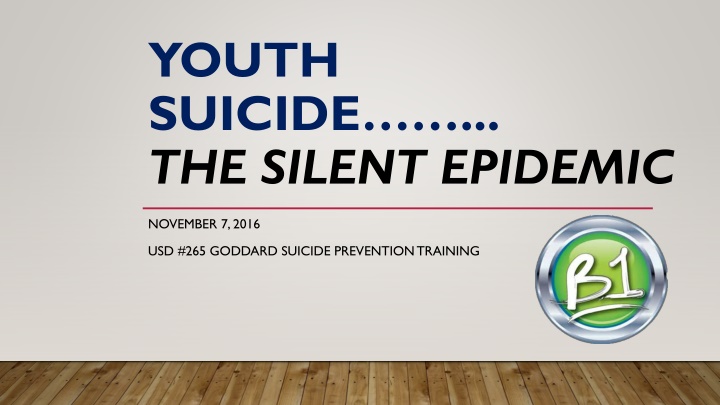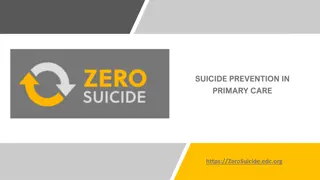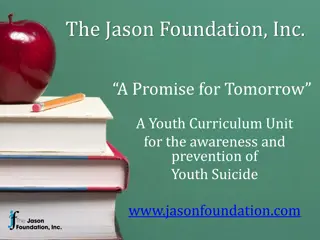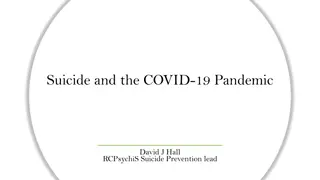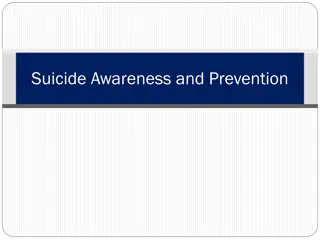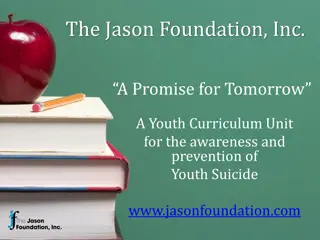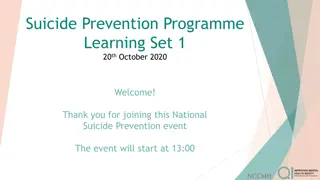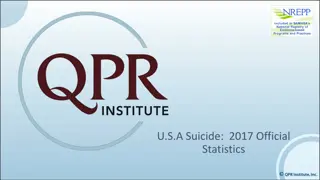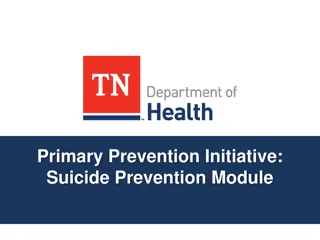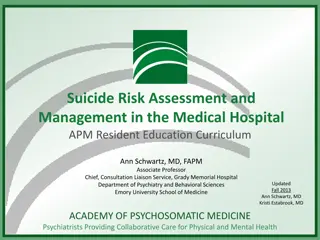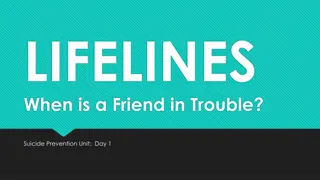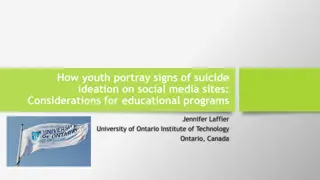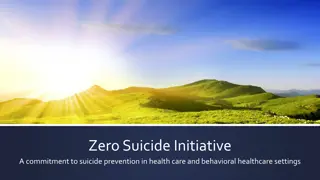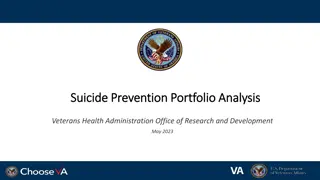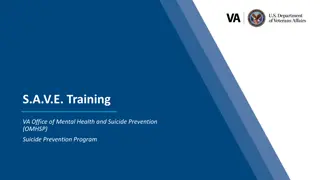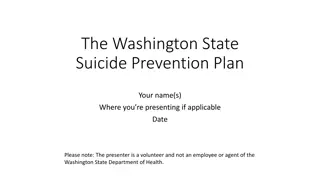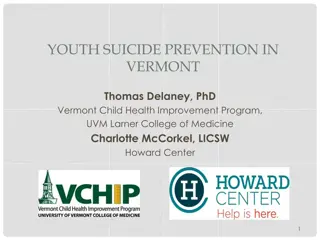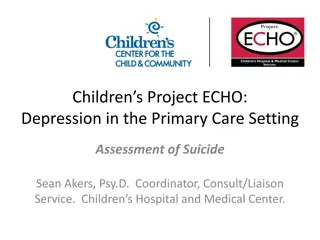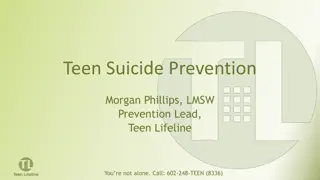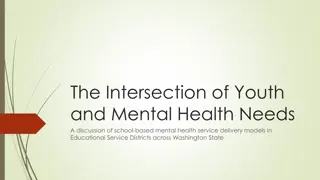Youth Suicide Prevention Training in Goddard: Fighting the Silent Epidemic
In November 2016, Goddard conducted suicide prevention training as part of the Jason Flatt Act to address the rising rates of youth suicide. The training aimed to equip school personnel with skills to recognize signs of concern and intervene effectively. The history of the act, its requirements, and the involvement of district counselors highlighted the importance of addressing this serious issue to protect our youth.
Download Presentation

Please find below an Image/Link to download the presentation.
The content on the website is provided AS IS for your information and personal use only. It may not be sold, licensed, or shared on other websites without obtaining consent from the author.If you encounter any issues during the download, it is possible that the publisher has removed the file from their server.
You are allowed to download the files provided on this website for personal or commercial use, subject to the condition that they are used lawfully. All files are the property of their respective owners.
The content on the website is provided AS IS for your information and personal use only. It may not be sold, licensed, or shared on other websites without obtaining consent from the author.
E N D
Presentation Transcript
YOUTH SUICIDE ... THE SILENT EPIDEMIC NOVEMBER 7, 2016 USD #265 GODDARD SUICIDE PREVENTION TRAINING
WHY AM I BEING TRAINED? We ALL care about kids Suicide is a preventable threat to our kids, friends and family. Thoughts of suicide and rates of completion have increased nationally, in the state of Kansas, and we have been touched by this tragedy here in Goddard. Because of this, Kansas joined 18 other states in passing the Jason Flatt Act in July, which requires that all school personnel be trained annually to become part of the solution. Suicide is hard to talk about. It is much harder, however, to face the results if you don t have that conversation. We re here to help.
BY THE END OF OUR TIME TOGETHER EACH OF YOU SHOULD . Understand the impact of suicide on our youth & the sequence of suicide & the risk factors that may increase a person s likelihood of suicide Be able to recognize signs of concern Know what to do if you have a concern & the protocol for Goddard USD 265
YOUR DISTRICT COUNSELORS Grades 7-8 Grades K-4 Kacie Bentemen -Amelia Earhart Joey Buresh - Oak Street Tina Markham Apollo Paige Koeppen - Clark Davidson Jenny Schrader - Explorer Sheila Raleigh - Eisenhower Middle Lisa Tyler - Goddard Middle Grades 9-12 Lee Keller - Academy Kayla Russell - Eisenhower High Jessica Seiler - Eisenhower High Kim Hoetmer - Goddard High Michelle Murray-Cline - Goddard High Grades 5-6 Megan Alexander Challenger Carolyn Long - Discovery
HISTORY & BACKGROUND Jason Flatt, a 16 year old from Tennessee, enjoyed going places and trying new things. He was a good student who loved sports, especially football. He had lots of friends and seemed to be full of life. Jason died by suicide on July 16, 1997. His family has been raising awareness of teen suicide ever since. 2001 - The Jason Foundation began advocating for legislation to include suicide awareness and prevention training at teacher in-services. 2007 - Tennessee was the first state to pass the Jason Flatt Act. The Jason Foundation jasonfoundation.com 2016 Kansas joined the cause.
REQUIREMENTS OF THE KANSAS JASON FLATT ACT (KSA 72-8260) ALL school personnel will be trained. 1 hour of training annually after initial implementation. Parents and guardians will be notified and training materials made available for review. Each building will develop a crisis plan that includes: recognition of suicide ideation; appropriate interventions; and a crisis recovery plan we have a district crisis plan in place.
WHAT DO WE KNOW ABOUT SUICIDE HOW MANY LIVES ARE LOST? Suicide is the 2nd leading cause of death for youth between the ages of 10-24. More young people die from suicide than from cancer, heart disease, AIDS, birth defects, stroke, pneumonia, influenza, and chronic lung disease, COMBINED. There are an average of 4,800 suicide attempts by young people. Suicide results in the death of approximately 4,600 young people each year. Although females are more likely to have thoughts of and even attempt suicide, males are about 4 times more likely to complete. Suicide Facts at a Glance 2015 Centers for Disease Control and Prevention cdc.org
YOUTH SUICIDE HOW ARE THEY DYING? Individuals who take their own life often test positive for alcohol and other drugs like anti- depressants, opiates, prescription pain medications or heroin. Top three methods used in youth suicide include: firearms (45%), suffocation (40%) and poisoning (8%). Centers for Disease Control and Prevention cdc.org (2014 CDC WISQARS) The Jason Foundation jasonfoundation.com
CDC YOUTH RISK BEHAVIORAL SURVEY Sad and/or hopeless Have felt sad and/or hopeless in the last 12 months? Thoughts of suicide 2009 National n/a 2014 National 29.9% 2014 Kansas 24% Plans Attempt 1 in 4
CDC YOUTH RISK BEHAVIORAL SURVEY Sad and/or hopeless Have you considered suicide in the last 12 months? Thoughts of suicide 2009 National 13.8% 2014 National 17% 2014 Kansas 16.4% Plans Attempt 1 in 6
CDC YOUTH RISK BEHAVIORAL SURVEY Sad and/or hopeless Have you made a plan to commit suicide in the last 12 months? Thoughts of suicide 2009 National 10.9% 2014 National 13.6% 2014 Kansas 12.5% Plans Attempt 1 in 8
CDC YOUTH RISK BEHAVIORAL SURVEY Sad and/or hopeless Have you attempted to commit suicide in the last 12 months? Thoughts of suicide 2009 National 6.3% 2014 National 8.0% 2014 Kansas 8.4% Plans Attempt 1 in 12
WHAT FACTORS PUT OUR KIDS AT INCREASED RISK? MENTAL HEALTH CONDITIONS Conduct Disorder Borderline Personality Disorder Perfectionist Personality Schizophrenia Serious or chronic health condition and/or pain Depression Bipolar Disorder Anxiety Disorders Substance abuse HISTORY Previous suicide attempts Family history of suicide American Foundation for Suicide Prevention afsp.org
WHAT FACTORS PUT OUR KIDS AT INCREASED RISK? ENVIRONMENTAL FACTORS Stressful life events - death, divorce, or job loss Prolonged stress factors harassment, bullying, relationship problems, unemployment Access to lethal means - firearms and drugs Exposure to another person s suicide or sensationalized accounts of suicide Abused, Molested, and/or Neglected Parental history of violence, substance abuse, or divorce American Foundation for Suicide Prevention afsp.org
WHAT FACTORS PUT OUR KIDS AT INCREASED RISK? SOCIAL RISK FACTORS GLBTQ Learning disabled Socially disconnected Low self-esteem Legal issues Academically at-risk PROTECTIVE FACTORS
WHAT ROLE DO YOU PLAY? Students spend more than 1,000 hours in school or school activities each year. You interact daily with your students. Your ability to recognize suicide risk is vital. You may be the first and You may be the first and last person to see last person to see or notice s some warning ome warning signs in a young person. young person. or notice signs in a
WHEN SHOULD YOU BE CONCERNED? Talking about suicide and/or talking about plans to commit suicide Communicating feeling hopeless, helpless, or worthless- I wish I was dead, I m just a burden to everyone A deepening depression A loss of interest in the things one cares about Preoccupation with death Out of character behavior Four out of five teens who attempt suicide have given clear warning signs. Taking unnecessary risks or exhibiting self-destructive behavior Making final arrangements Visiting or calling people one cares about Giving prized possessions away
American Association of Suicidology suicidology.org MISCONCEPTIONS #1 Asking about suicide puts the thought of killing oneself in someone s head. #2 You have to keep it a secret to protect them.
IF YOU SEE SIGNS OF CONCERN START WITH Ask if they are okay or if they are having thoughts of suicide. Express concern about what you are observing in their behavior. Listen attentively and non-judgmentally. Let them know they have been heard. Tell them they are not alone. If you have concerns about anyone, REPORT!
IF YOU SEE SIGNS OF CONCERN NEXT STEPS If any employee has reason to believe, either through direct observation, knowledge or a report from someone that a person is in danger of harming themselves, that employee must report the situation immediately according to the following procedure: A. Do not leave the student alone B. Contact the counselor, social worker, administrator, or USD 265 Police C. District protocol will be continued by members of the crisis team. Parents Mental Health Evaluation Counselor Social Worker Administration USD 265 Staff Member
REMEMBER Never be reluctant to get involved AND
TAKE EVERY THREAT SERIOUSLY If incident occurs at a school activity or after school hours and an administrator is not available, call USD 265 police at (316) 640-9510 or 911.
NATIONAL AND COMMUNITY RESOURCES ComCare Crisis-660-7500- Provides 24/7 Walk-In Assessment or Call for Support. National Suicide Prevention Lifeline- 1-800-273-TALK (8255) www.suicidepreventionlifeline.org/GetHelp/LifelineChat.aspx Crisis Text Line - Text CTL or LISTEN to 741-741 - www.crisistextline.org/ The Jason Foundation-www.jasonfoundation.com They also have a phone app www.jasonfoundation.com/get-involved/student/a- friend-ask-app/ that Lists Warning Signs, Explains What to Say and What Not to Say, Gives a Crisis Number if away from school and resources. B1 Cards- for your district reference.
Thank you for helping us work together to take care of our students when it comes to dealing with this silent epidemic.
